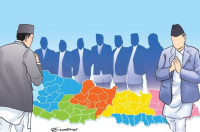Opinion
Get insured
Recently-introduced health insurance scheme will not succeed without people’s understanding and participation
Kahar Singh Khadka
These days we frequently come across advertisements for the health insurance scheme recently introduced by the Ministry of Health (MoH). The public promotional ad includes an appeal to the general public to register their names in the scheme, which was launched with the aim of providing health security coverage and ensuring access to quality health care at an affordable cost for all citizens.
The government aims to bring the entire national population under the insurance coverage within three years by covering at least an additional 25 districts every successive year. It seems a challenging task to achieve such an ambitious goal within that time frame. The progress of the programme currently running in eight districts is not satisfactory, mainly because the rate of participation is very low.
Better informed
Before we start to examine the various aspects of the insurance scheme including enrolment, benefit packages, sustainability and quality of health services, it is better to know about the scheme and the process of becoming a member because most people are unaware about them.
It is a community-based health insurance programme which involves prepayment and the pooling of resources to protect against the cost of illness. It operates within the scope of a family, so it can be viewed as a family-based insurance programme. All the members of the family need to get registered and make an Individual Identity Card. Registration assistants visit every household in the community for the promotion of the insurance scheme. A five-member family will have to pay an annual premium of Rs2,500. For a family with more than five members, an extra Rs425 will have to be paid for each additional member. In return, each family will receive a benefit package of up to Rs50,000 annually for medical treatment. An additional member will get a financial coverage of up to Rs10,000, but the package amount cannot exceed Rs100,000 in total.
As of now, medical treatment for insured families is only available at government-run health care centres. But the MoH has been trying to find a way to make services available at private hospitals, too. The insured members cannot go to any government hospital they choose, except in cases of emergency. This is because members must choose a specific health care provider while filling the registration form.
Prior to this, Nepalis did not have any experience of a community-based health insurance scheme. A few pilot projects were launched, but their reach was limited. There is no statute law relating to health insurance in the country. The MoH has drafted a bill, but it is yet to be endorsed. Even private insurance companies do not sell health insurance policies like this. They have only issued an accidental health insurance policy, which apply only in the case of accidents. Nepal obviously has a long way to go to reach the level of developed countries in terms of providing health insurance for its citizens.
Why low enrolment?
There are many reasons behind the low enrolment. An important one is the lack of knowledge about health insurance. Even those who are mindful of their health are not convinced that insurance helps them minimise their health care cost. Some people even say that if no family member falls sick within a year, then the family will lose their Rs2,500. It’s a little strange that some people do not seem to understand there is always a possibility of them falling sick at any given time, and that by investing a little money, they can have access to a larger amount at their time of need.
It’s true that there are many others for whom the insurance scheme is not financially viable. The government has allocated a monetary fund for the poor with the purpose of involving them in the insurance scheme, but that fund has not been fully utilised as the intended beneficiary has to show a Poor Identity Card. Many people who qualify haven’t received the card. There are many disadvantaged, marginalised and differently-abled people who also need to be brought under the insurance scheme. So the MoH should come up with a plan to find an alternative source of finance for them.
The benefit package provided by the government is acceptable in the present context. It can offer financial protection for those who cannot afford the high cost of medical expenses. But people have doubts that the health service provided under this scheme will be of the same quality as the one provided to those who pay out of pocket. Such doubts are also responsible for low enrolment in the scheme. To dispel the doubts, a health insurance policy paper should be issued along with an ID card, clearly mentioning the contents of the services and their quality and potential benefits.
In conclusion, the health insurance programme shows the government’s commitment to public health. But without people’s informed understanding and active involvement, the health insurance scheme may not be utilised by the intended population. So the MoH should ramp up efforts to make people more aware of the benefits of health insurance. The government also needs support from various concerned stakeholders to make the programme successful.
Khadka is chairperson of Prakriya Nepal, an NGO working in the field of health, education and consumer rights




 9.12°C Kathmandu
9.12°C Kathmandu










